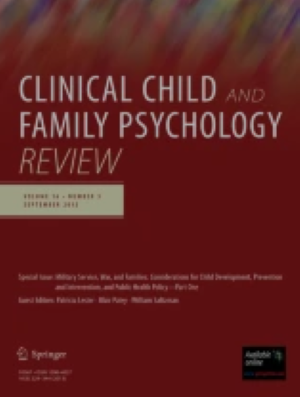A Systematic Review and Evidence Gap Map Evaluation of Rhythmic and/or Complex Movement Interventions and Child Cognitive Outcomes.
IF 6.1
1区 心理学
Q1 PSYCHOLOGY, CLINICAL
引用次数: 0
Abstract
Optimal child cognitive developmental outcomes occur when the environment provides opportunities for challenge, development, and structure. For some children, additional support is required, with many interventions including a rhythmic element (e.g. instrumental music or group singing), or complex coordinated physical movement (e.g. structured sport or physical activity classroom breaks), to support cognitive development. While many studies examine the impact of these interventions, and some existing reviews examine effectiveness in discrete topic areas, the field requires a comprehensive overview and consolidation of the extant evaluation literature to guide future meta-analyses and primary studies (including replications). This systematic review and Evidence Gap Map identifies and synthesises studies that evaluate interventions where rhythmic and/or complex coordinated physical components are explicitly included. A systematic search of 17 databases yielded 402 studies that evaluate the impact of these interventions on cognition (including executive function and memory) using a randomised, quasi-experimental, or single group design in children aged birth to 12 years. Findings suggest that there is high saturation in the literature for interventions that include complex coordinated movement (62.70% of total sample) and moderate representation of rhythmic interventions (21.80% of total sample). Interventions that included both complex coordinated movement and rhythmic elements, such as martial arts, dance, or gymnastics, were sparse (15.50% of total sample). Children in the early primary school years (ages six to ten years) are the most common target population, and executive function is the most commonly measured outcome. Findings identified gaps in the literature for further research and evaluation to include interventions that incorporate both a complex coordinated movement element and a rhythmic element; incorporate the use of more rigorous randomised controlled study designs when evaluating these interventions; and use of a broader range of measures to capture different aspects of cognitive functioning (e.g. memory). These findings should inform the development and focus of future intervention studies, which in due course will lead to systematic reviews and network meta-analysis.PROSPERO Registration Number: CRD42021248436.节奏和/或复杂运动干预与儿童认知结果的系统回顾和证据缺口图评估。
当环境为挑战、发展和结构提供机会时,儿童认知发展的最佳结果就会出现。对于一些儿童,需要额外的支持,包括许多干预措施,包括节奏元素(如器乐或集体歌唱),或复杂的协调身体运动(如有组织的运动或体育课课间休息),以支持认知发展。虽然许多研究检查了这些干预措施的影响,一些现有的综述检查了离散主题领域的有效性,但该领域需要对现有评估文献进行全面的概述和巩固,以指导未来的荟萃分析和初步研究(包括重复研究)。本系统综述和证据差距图确定并综合了评估明确包括节奏和/或复杂协调物理成分的干预措施的研究。通过对17个数据库的系统搜索,得出402项研究,这些研究采用随机、准实验或单组设计,对出生至12岁儿童的认知(包括执行功能和记忆)进行了评估。研究结果表明,文献中对复杂的协调运动干预(占总样本的62.70%)和适度的节奏性干预(占总样本的21.80%)存在较高的饱和度。包括复杂协调运动和节奏元素的干预措施,如武术、舞蹈或体操,很少(占总样本的15.50%)。小学早期阶段的儿童(6至10岁)是最常见的目标人群,执行功能是最常见的测量结果。研究结果确定了文献中的空白,以供进一步研究和评估,包括结合复杂协调运动元素和节奏元素的干预措施;在评估这些干预措施时,采用更严格的随机对照研究设计;并使用更广泛的测量方法来捕捉认知功能的不同方面(例如记忆)。这些发现应该为未来干预研究的发展和重点提供信息,在适当的时候,这些研究将导致系统评价和网络荟萃分析。普洛斯彼罗注册号:CRD42021248436。
本文章由计算机程序翻译,如有差异,请以英文原文为准。
求助全文
约1分钟内获得全文
求助全文
来源期刊

Clinical Child and Family Psychology Review
PSYCHOLOGY, CLINICAL-
CiteScore
10.50
自引率
4.30%
发文量
45
期刊介绍:
Editors-in-Chief: Dr. Ronald J. Prinz, University of South Carolina and Dr. Thomas H. Ollendick, Virginia Polytechnic Institute Clinical Child and Family Psychology Review is a quarterly, peer-reviewed journal that provides an international, interdisciplinary forum in which important and new developments in this field are identified and in-depth reviews on current thought and practices are published. The Journal publishes original research reviews, conceptual and theoretical papers, and related work in the broad area of the behavioral sciences that pertains to infants, children, adolescents, and families. Contributions originate from a wide array of disciplines including, but not limited to, psychology (e.g., clinical, community, developmental, family, school), medicine (e.g., family practice, pediatrics, psychiatry), public health, social work, and education. Topical content includes science and application and covers facets of etiology, assessment, description, treatment and intervention, prevention, methodology, and public policy. Submissions are by invitation only and undergo peer review. The Editors, in consultation with the Editorial Board, invite highly qualified experts to contribute original papers on topics of timely interest and significance.
 求助内容:
求助内容: 应助结果提醒方式:
应助结果提醒方式:


